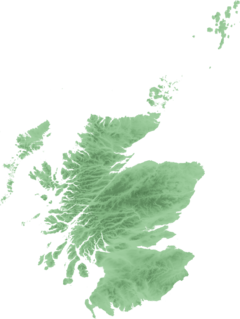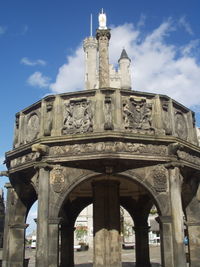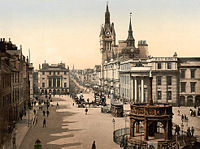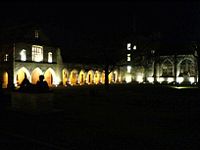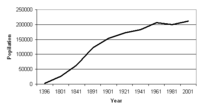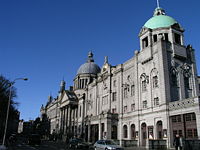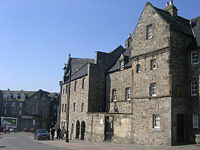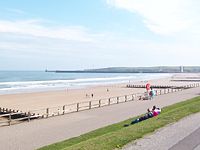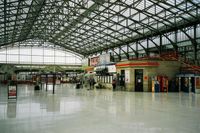Aberdeen
2008/9 Schools Wikipedia Selection. Related subjects: British Cities; Great Britain
| Aberdeen | |
| Scottish Gaelic: Obar Dheathain | |
| Scots: Aiberdeen | |
| Granite City, Oil Capital of Europe, Silver City | |
|
Image:Aberdeen-coa.png
|
|
|
Aberdeen shown within Scotland |
|
| Population | 202,370 |
|---|---|
| - Density | 2819 mile² (1,089 km²) |
| Language | English |
| Scots ( Doric) | |
| OS grid reference | |
| - Edinburgh | 94 miles (151 km) |
| - London | 403 miles (649 km) |
| Parish | Presbytery of Aberdeen |
| Council area | Aberdeen City Council |
| Lieutenancy area | Aberdeen |
| Constituent country | Scotland |
| Sovereign state | United Kingdom |
| Post town | ABERDEEN |
| Postcode district | AB10-AB13 (part), AB15, AB16, AB22-AB25 |
| Dialling code | 01224 |
| Police | |
| Fire | |
| Ambulance | Scottish |
| European Parliament | Scotland |
| UK Parliament | Aberdeen South |
| Aberdeen North | |
| Gordon | |
| Scottish Parliament | North East Scotland |
| Aberdeen Central | |
| Aberdeen North | |
| Aberdeen South | |
| Website: aberdeencity.gov.uk | |
| List of places: UK • Scotland | |
Coordinates:
Aberdeen ( IPA: /abɚdin/ ; Scottish Gaelic: Obar Dheathain) is Scotland's third largest city with a population of 202,370. Locals call it the Granite City and the Silver City with the Golden Sands, since much of the city was built of grey granite which the loyal locals see as shimmering like silver in the sun.. It is also called the Oil Capital of Europe after the discovery of North Sea oil.
The area around Aberdeen has had human settlement for at least 8,000 years, when small villages lay around the mouths of the River Dee and River Don. The city's name came from the Celtic 'Aber' meaning "the mouth of" and the river name Dee, literally meaning at the mouth of the Dee. Old Aberdeen, to the north of the modern city and on the river Don, was formerly known as "Aberdon".
In 1319, it received Royal Burgh status from Robert the Bruce, transforming the city economically. The city's two universities, University of Aberdeen, founded in 1495, and the Robert Gordon University, which was awarded university status in 1992, make Aberdeen the educational centre of the north-east. The traditional industries were fishing, paper-making, shipbuilding and textiles, but they have been overtaken by the oil industry and Aberdeen's seaport. The seaport is the largest in the northeast of Scotland.
Aberdeen has won the Britain in Bloom competition ten times, and hosts the Aberdeen International Youth Festival.
History
The Aberdeen area has seen human settlement for at least 8,000 years. The city began as two separate burghs: Old Aberdeen at the mouth of the river Don; and New Aberdeen, a fishing and trading settlement, where the Denburn waterway entered the river Dee estuary. The earliest charter was granted by William the Lion in 1179 and confirmed the corporate rights granted by David I. In 1319, the Great Charter of Robert the Bruce transformed Aberdeen into a property-owning and financially independent community. Granted with it was the nearby Forest of Stocket, whose income formed the basis for the city's Common Good Fund which still benefits Aberdonians.
During the Wars of Scottish Independence, Aberdeen was under English rule, so Robert the Bruce laid siege to Aberdeen Castle before destroying it in 1308 followed by the massacring of the English garrison and the retaking of Aberdeen for the townspeople. When Bruce took over the castle and finished the siege, Bon Accord was used as the code to initiate the final attack and has been the city's motto ever since. The city was burned by Edward III of England in 1336, but was rebuilt and extended, and called New Aberdeen. The city was strongly fortified to prevent attacks by neighbouring lords, but the gates were removed by 1770. During the Wars of the Three Kingdoms of 1644-1647 the city was impartially plundered by both sides. In 1644, it was taken and ransacked by Royalist troops after the Battle of Aberdeen. A quarter of the population died in 1647 from an outbreak of bubonic plague.
In the 18th century, a new Town Hall was built and the first social services appeared with the Infirmary at Woolmanhill in 1742 and the Lunatic Asylum in 1779. The council began major road improvements at the end of the century with the main thoroughfares of George Street, King Street and Union Street all completed at the start of the next century.
A century later, the increasing economic importance of Aberdeen and the development of the shipbuilding and fishing industries led to the existing harbour with Victoria Dock, the South Breakwater, and the extension to the North Pier. The expensive infrastructure program had repercussions, and in 1817 the city was bankrupt. However, a recovery was made in the general prosperity which followed the Napoleonic wars. Gas street lighting arrived in 1824 and an enhanced water supply appeared in 1830 when water was pumped from the Dee to a reservoir in Union Place. An underground sewer system replaced open sewers in 1865.
The city was first incorporated in 1891. Although Old Aberdeen still has a separate charter and history, it and New Aberdeen are no longer truly distinct. They are both part of the city, along with Woodside and the Royal Burgh of Torry to the south of the River Dee.
Architecture
Union Street, built of granite in 1801-05, runs from Castle Street for nearly a mile (1.5 km), is 70 feet (21 m) wide, and originally contained the principal shops and most public buildings. Part of the street crosses the Denburn ravine (utilised for the line of the Great North of Scotland Railway) by Union Bridge, a granite arch of 132 feet (40 m) span, with portions of the older town still fringing the gorge, 50 feet (15 m) below the level of Union Street.
The Town House, built in Franco-Scottish Gothic style, is at the east end of Union Street. Containing the great hall, with an open timber ceiling and oak-panel walls, the Sheriff Court House and the Town and County Hall contains portraits of various Lord Provosts and distinguished citizens. On the south-western corner is the 210 foot (64 m) grand tower high enough to give a view of the city and surrounding country. Adjoining the Town House is the old North of Scotland Bank building, in Greek Revival style.
Other notable buildings on the street are the Town and County Bank, the Music Hall, the Trinity Hall of the incorporated trades (1398-1527, now a shopping centre), the Palace Hotel, and the former office of the Northern Assurance Company. Many of the city's most renowned buildings were designed by local architect Archibald Simpson. Just off Union Street, Marischal College is the second largest granite building in the world. Its present frontage was inaugurated by King Edward VII in 1906, but the central parts by Archibald Simpson are considerably older.
The Mercat Cross, built in 1686 by John Montgomery, is an open-arched structure, 21 feet (6 m) in diameter and 18 feet (5 m) high with a large hexagonal base from the centre of which rises a shaft with a Corinthian capital, on which is the royal unicorn. The base is highly decorated, including medallions illustrating Scottish monarchs from James I to James VII.
Notable religious buildings are the Kirk of St Nicholas, in the centre of the city, with a large kirkyard separated from Union Street by a 147 foot (45 m) long Ionic facade, built in 1830. The divided church within, with a central tower and spire, forms one continuous building 220 feet (67 m) in length. In Old Aberdeen, St. Machar's Cathedral was started in the 12th century but took centuries to complete with the exception of the period of the episcopates of William Elphinstone and Gavin Dunbar, who completed the structure by adding the two western spires and the southern transept.
The ancient Brig o' Balgownie, a picturesque single arch spanning the deep black stream, is said to have been built by King Robert I. The Bridge of Dee consists of seven semicircular ribbed arches, is about 30 feet (10 m) high, and was built early in the 16th century by Bishops Elphinstone and Dunbar. It was nearly all rebuilt in 1718-1723 and in 1842 was widened from 14 to 26 feet (4 to 8 m) wide.

Religion
Traditionally Christian, Aberdeen's largest denominations are the Church of Scotland through the Presbytery of Aberdeen and the Catholic faith. The last census revealed that Aberdeen is the least religious city in Scotland, with nearly 43 % of people claiming to have no religion and several former churches in the city have been converted into bars and restaurants.
There is also an Islamic Mosque in Old Aberdeen and a small informal Jewish congregation. There is no formal Buddhist or Hindu building. The University of Aberdeen has a small Bahá'í society.
In the Middle Ages, the Kirk of St Nicholas was the only burgh kirk and one of Scotland's largest parish churches. Like a number of other Scottish kirks, it was subdivided after the Reformation, in this case into the East and West churches. At this time, the city also was home to houses of the Carmelites ( Whitefriars) and Franciscans Greyfriars), the latter or which surviving in modified form as the chapel of Marischal College as late as the early 20th Century.
St Machar's Cathedral was formed twenty years after David I (1124-53) transferred the pre-Reformation Diocese from Mortlach in Banffshire to Old Aberdeen in 1137. With the exception of the episcopate of William Elphinstone (1484-1511), building progressed slowly. Gavin Dunbar, who followed him in 1518, completed the structure by adding the two western spires and the southern transept.
St. Mary's Cathedral is a Roman Catholic Cathedral in Gothic style, erected in 1859.
St. Andrew's Cathedral is the Scottish Episcopal Cathedral, constructed in 1817 as Archibald Simpson's first commission. It is notable for having consecrated the first bishop of the Episcopal Church in the United States of America.
Economy
Traditionally, Aberdeen was home to fishing, textile mills, ship building and paper making. These industries have all but gone now and have been replaced. High technology developments in the electronics design and development industry, research in agriculture and fishing and of course the oil industry, which has been largely responsible for Aberdeen's economic boom in the last three decades, are now major parts of Aberdeen's economy.
Until the 1970s, most of Aberdeen's leading industries dated from the 18th Century; mainly these were textiles, foundry work, shipbuilding and paper-making &mdash, the oldest industry in the city, with paper having been first made there in 1694. Paper-making has reduced in importance since the closures of Donside Paper Mill in 2001 and the Davidson Mill in 2005 leaving the Stoneywood Paper Mill with a workforce of approximately 500. Textile production ended in 2004 when Richards of Aberdeen closed.
Grey granite was quarried at Rubislaw quarry for more than 300 years, and used for paving setts, kerb and building stones, and monumental and other ornamental pieces. Aberdeen granite was used to build the terraces of the Houses of Parliament and Waterloo Bridge in London. Quarrying finally ceased in 1971.
Fishing was once the predominant industry, but was surpassed by deep-sea fisheries, which derived a great impetus from improved technologies throughout the 20th Century. Catches have fallen due to overfishing and the use of the harbour by oil support vessels, and so although still an mportant fishing port it is now eclipsed by the more northerly ports of Peterhead and Fraserburgh. The Fisheries Research Services is based in Aberdeen, including its headquarters, and a marine research lab in Torry.
Aberdeen is well regarded for the agricultural and soil research that takes place at The Macaulay Institute, which has close links to the city's two universities. The Rowett Research Institute is a world renowned research centre for studies into food and nutrition located in Aberdeen. It has produced three Nobel laureates and there is a high concentration of life scientists working in the city.
There is also a dynamic and fast growing electronics design and development industry.
With the discovery of significant oil deposits in the North Sea during the late 20th Century, Aberdeen became the centre of Europe's petroleum industry. With the second largest heliport in the world and an important service ship harbour port serving oil rigs off-shore, Aberdeen is often called the Oil Capital of Europe.
Local political attempts have been made to turn Aberdeen's reputation as the Oil Capital of Europe into the Energy Capital of Europe as oil supplies may start to dwindle in coming years, and there is considerable interest in the development of new energy sources; technology transfer from oil to other industries is anticipated.
Aberdeen has managed to avoid the dilapidation of city centres as often seen in the late 20th century, with only supermarkets and "warehouse" style stores in the outlying areas of the city. The city ranks fourth in Scotland for shopping. The centre has remained relatively prosperous, although Union Street has more than its fair share of discount stores and empty units. The traditional shopping streets are Union Street and George Street which are now backed up by inner-city shopping centres, notably the Bon Accord-St Nicholas Centre and the The Mall Trinity.
Education
Universities and colleges
Aberdeen has two universities, the University of Aberdeen and Robert Gordon University. Aberdeen has a higher student rate than the national average of 11.5% compared to 7% nationally.
The University of Aberdeen began life as King's College, Aberdeen, which was founded in 1495 by William Elphinstone (1431-1514), Bishop of Aberdeen and Chancellor of Scotland. Marischal College, a separate institution, was founded in "New" Aberdeen by George Keith, 5th Earl Marischal of Scotland in 1593. These institutions were amalgamated to form the present University of Aberdeen in 1860. The university is the fifth oldest in the English speaking world.
Robert Gordon's College (originally Robert Gordon's Hospital) was founded in 1729 by the merchant Robert Gordon, grandson of the map maker Robert Gordon of Straloch, and was further endowed in 1816 by Alexander Simpson of Collyhill. Originally devoted to the instruction and maintenance of the sons of poor burgesses of guild and trade in the city, it was reorganised in 1881 as a day and night school for secondary and technical education. In 1903, the vocational education component of the college was designated a Central Institution and was renamed as the Robert Gordon Institute of Technology in 1965. In 1992, university status was gained and it became the Robert Gordon University.
Aberdeen is also home to two artistic schools: Gray's School of Art, founded in 1886, which is one of the oldest established colleges of art in the UK, and is now incorporated into Robert Gordon University; and The Scott Sutherland School of Architecture and The Built Environment, which is situated on the Garthdee Campus of the Robert Gordon University, next to Gray's School of Art.
Aberdeen College has several campuses in the city and offers a wide variety of part-time and full-time courses leading to several different qualifications. It is the largest further education institution in Scotland.
Schools
There are currently 12 secondary schools and 54 primary schools which are run by the city council. The most notable are Cults Academy, Oldmachar Academy and Aberdeen Grammar School (founded in 1263) which were all rated in the top 50 Scottish secondary schools league tables published by The Times in 2005.
There are a number of private schools in Aberdeen; Albyn School for Girls (co-educational as of 2005), St Margaret's School for Girls, the Hamilton School (a Montessori school), Robert Gordon's College, the Total French School (for French oil industry families), the International School of Aberdeen and a Waldorf/Steiner School.
Geography
Climate
The mean temperature is 8 °C (47 °F) and it varies between an average low of 5 °C (41 °F) and 11 °C (52 °F). In summer (June - August) the average high is 16 °C (63 °F) and average low 9 °C (49 °F). In winter (December - February) the average high is 6 °C (43 °F) and average low 0 °C (33 °F).
The average yearly precipitation is 753 millimetres (29.7 in), with 64 millimetres (2.5 in) in summer (June - August) and 62 millimetres (2.5 in) in winter (December - February). The wettest months are October and November.
Demographics
In 1396 the population was about 3,000. By 1801 it had become 26,992; (1901) 153,503; (1941) 182,467. In 2001 the UK census records the Aberdeen City Council area's population at 212,125, but the Aberdeen locality's population at 184,788. The latest official population estimate, published by the General Register for Scotland for 2005, is 202,370. Data from the Aberdeen specific locality of the 2001 UK census shows that the demographics include a median male age of 35 and female age of 38 which are younger than Scotland's average and a 49% to 51% male to female ratio.
The census showed that there are less young people in Aberdeen, with 16.4 % under 16, opposed to the national average of 19.2 %. Ethnically, 15.7 % were born outside of Scotland, higher than the national average of 12.9 %. Of this population 8.4 % were born in England. 3 % of Aberdonians stated to be from an ethnic minority (non-white) in the 2001 census, with 0.7% from the Indian-subcontinent and 0.6% Asian, in comparison Scotland's overall population of non-white origin is 2 %. However this is a lower percentage than any of Scotland's other three main cities, Glasgow, Edinburgh, and Dundee.
In the household, there were 97,013 individual dwellings recorded in the city of which 61% were privately owned, 9% privately rented and 23% rented from the council. The most popular type of dwellings are apartments which compromise 49% of residences followed by semi-detached at just below 22%. The average income of a household in the city is £16,813 (2005) which places approximately 18% households in the city below the poverty line (defined as 60% of the mean income).
Geology
Aberdeen has grown over a site of mainly metamorphic quartzite mica schist, formed during the Dalradian period (approximately 480-600 million years ago) with sporadic areas of igneous Diorite grainites to be found, such as that at the Rubislaw quarry which was used to build much of the Victorian parts of the city.
On the coast, Aberdeen has a long sand beach between the two rivers, the Dee and the Don, which turns into high sand dunes north of the Don stretching as far as Fraserburgh and to the south of the Dee rocky cliff faces with pebble and shingle beaches.
Topography
The city extends to 71.22 square miles (184.46 km²), and includes the former burghs of Old Aberdeen, New Aberdeen, Woodside and the Royal Burgh of Torry to the south of River Dee. This gives the city a population density of 2819 square miles (1,089 km²).The city is built on many hills, with the original beginnings of the city growing from Castle Hill, St. Catherine's Hill and Windmill Hill (also known as the Gallowgate).
Culture
The city is blessed with amenities which cover a wide range of cultural activities and boasts a selection of museums. The city is regularly visited by Scotland's National Arts Companies. The Aberdeen Art Gallery houses a collection of Impressionist, Victorian, Scottish and 20th Century British paintings as well as collections of silver and glass. It also includes The Alexander Macdonald Bequest, a collection of late 19th century works donated by the museum's first benefactor and a constantly changing collection of contemporary work and regular visiting exhibitions.
Museums and galleries
The Aberdeen Maritime Museum, located in Shiprow, tells the story of Aberdeen's links with the sea from the days of sail and clipper ships to the latest oil and gas exploration technology. It includes an 8.5m (28 feet) high model of the Murchison oil production platform and a 19th century assembly taken from Rattray Headlighthouse.
Provost Ross' House is the second oldest dwelling house in the city. It was built in 1593 and became the residence of Provost John Ross of Arnage in 1702. The house retains some original medieval features, including a kitchen, fire places and beam-and-board ceilings. The Gordon Highlanders Museum tells the story of one of Scotland's best known regiments.
Marischal Museum holds the principal collections of the University of Aberdeen, comprising some 80,000 items in the areas of fine art, Scottish history and archaeology, and European, Mediterranean & Near Eastern archaeology. The permanent displays and reference collections are augmented by regular temporary exhibitions.
Performing arts
Aberdeen is home to a host of events and festivals including the Aberdeen International Youth Festival (the world's largest arts festival for young performers), Aberdeen Jazz Festival, Rootin' Aboot (folk and roots music event based at The Lemon Tree), Triptych, and the University of Aberdeen's literature festival Word.
In 2006 Simon Farquhar's play Rainbow Kiss was staged at London's Royal Court Theatre. Directed by Richard Wilson and starring Joe McFadden and Dawn Steele, the play was an uncompromising depiction of Aberdeen life which, despite its strong sexual and violent content, won rave reviews from the liberal press and was applauded by MP for Aberdeen South Anne Begg.
Music and film
Aberdeen's music scene includes a variety of live music venues including pubs, clubs, and a number of churches with thriving choirs. The music scene is particularly prevalent in the bars of Belmont Street. Cèilidhs are also common in some of the city's halls. Popular venues include The Lemon Tree, The Tunnels, the Aberdeen Exhibition and Conference Centre, and Aberdeen Music Hall. Aberdonian musicians include Evelyn Glennie and Annie Lennox.
Cultural cinema, educational work and local film events are provided by The Belmont Picturehouse on Belmont Street, Peacock Visual Arts and The Foyer.
Open spaces
Aberdeen has long been famous for its 45 outstanding parks and gardens, and citywide floral displays which include two million roses, eleven million daffodils and three million crocuses. The city has won the Royal Horticultural Society's Britain in Bloom 'Best City' award ten times, the overall Scotland in Bloom competition twenty times and the large city category every year since 1968. At one point after winning a period of nine years straight, Aberdeen was banned from the Britain in Bloom competition to give another city a chance. The city won the 2006 Scotland in Bloom "Best City" award along with the International Cities in Bloom award. The suburb of Dyce also won the Small Towns award.
Duthie Park opened in 1899 on the north bank of the river Dee. It was named after and gifted to the city by Miss Elizabeth Crombie Duthie of Ruthrieston in 1881. It has extensive gardens, a rose hill, boating pond, bandstand, and play area as well Europe's second largest enclosed gardens the David Welch Winter Gardens. Hazlehead Park, is large and forested, located on the outskirts of the city, it is popular with walkers in the forests, sports enthusiasts, naturalists and picnickers. There are football pitches, two golf courses, a pitch and putt course and a horse riding school.
Aberdeen's success in the Britain in Bloom competitions is often attributed to Johnston Gardens, a small park of one hectare in the west end of the city containing many different flowers and plants which have been renowned for their beauty. The garden was in 2002, named the best garden in Britain.
Seaton Park, formerly the grounds of a private house, is on the edge of the grounds of St Machar's Cathedral. The Cathedral Walk is maintained in a formal style with a great variety of plants providing a popular display. The park includes several other areas with contrasting styles to this.
Union Terrace Gardens opened in 1879 and is situated in the centre of the city. It is a popular rendezvous location in the heart of the city with locals, in particular students and other young locals and is filled with trees of over 200 years old and flowers arranged in the city's coat of arms in summer.
Situated next to each other, Victoria Park and Westburn Park cover 26 acres between them. Victoria Park opened in 1871. There is a conservatory used as a seating area and a fountain made of fourteen different granites, presented to the people by the granite polishers and master builders of Aberdeen. Opposite to the north is Westburn Park opened in 1901. With large grass pitches it is widely used for field sports. There is large tennis centre with indoor and outdoor courts, a children's cycle track, play area and a grass boules lawn.
Dialect
The local dialect of Lowland Scots is often known as the Doric, and is spoken not just in the city, but across the north-east of Scotland. It differs somewhat from other Scots dialects most noticeable are the pronunciation f for what is normally written wh and ee for what in standard English would usually be written oo (Scots ui). Every year the annual Doric Festival takes place in Aberdeenshire to celebrate the history of the north-east's language.
As with all Scots dialects in urban areas, it is not spoken as widely as it used to be in Aberdeen. In the surrounding Aberdeenshire it can be heard quite commonly but within the city, some words are still commonly used, such as:
|
|
- Listen to recordings of a speaker of Scots from Aberdeen
Sport
Football is best represented in Aberdeen with the Scottish Premier League football club, Aberdeen FC, who play at Pittodrie. The club's major success was winning the European Cup Winners Cup and the European Super Cup in 1983, and three Scottish Premier League Championships between 1980 and 1985. The other senior team is Cove Rangers F.C. of the Highland Football League (HFL), who play at Allan Park in the suburb of Cove Bay.. Cove won the HFL championship in 2001.
In rugby, the city is home to the BT Premiership Division One rugby club Aberdeen GSFP RFC who play at Rubislaw Playing Fields, and also Aberdeen Wanderers RFC whose most famous former player Jason White, is captain of the Scotland national rugby union team.
Golfing provision is excellent, and The Open Championship winner of 1999 Paul Lawrie hails from the city. The oldest golf club in the city is the Royal Aberdeen Golf Club which was founded in 1780 and which hosted the Senior British Open in 2005. The club has a second course, and there are public golf courses at Auchmill, Balnagask, Hazlehead and King's Links.
The City of Aberdeen Swim Team (COAST) is based in Northfield swimming pool and have been in operation since 1996. The team comprises several smaller swimming clubs, and has enjoyed success throughout Scotland and in international competitions. Three of the team's swimmers qualified for the 2006 Commonwealth Games.
The city council operates public tennis courts in various parks including an indoor tennis centre at Westburn Park. The Beach Leisure Centre is home to a climbing wall and gymnasium and there are numerous swimming pools dotted around the city notably the largest, the Bon-Accord Baths.
Infrastructure
Health
Aberdeen's health is provided for most people by NHS Scotland through the NHS Grampian health board. Aberdeen Royal Infirmary is the main hospital in the city, with the Royal Aberdeen Children's Hospital for children, the Royal Cornhill Hospital for mental health and the Woodend Hospital and Woolmanhill Hospitals.
Privately there is the Albyn Hospital on Albyn Place which is owned and operated by BMI Healthcare.
Transport
Aberdeen Airport (ABZ), at Dyce in the north of the city, serves a number of domestic and international destinations including France, Netherlands and Scandinavian countries. The heliport which serves the oil industry and rescue services is the busiest commercial heliport in the world.
Aberdeen railway station is on the main UK rail network and connects directly to major cities such as Edinburgh and London. Many services from London actually terminate at Dyce, serving the airport.
There are five major roads in and out of the city. The A90 is the main arterial route into the city from the north and south, linking Aberdeen to Edinburgh, Dundee and Perth in the south and Ellon, Peterhead and Fraserburgh in the north. The A96 links to Elgin and Inverness and the north west. The A93 is the main route to the west, heading towards Royal Deeside and the Cairngorms. After Braemar, it turns south, providing an alternative tourist route to Perth. The A92 was the original southerly road to Aberdeen prior to the building of the A90, and is now used as a tourist route, connecting the towns of Montrose, Arbroath and Brechin on the east coast. The A947 exits the city at Dyce and goes on to Newmachar, Oldmeldrum and Turriff finally ending at Banff and Macduff
Aberdeen Harbour is important as the largest in the north of Scotland and as a ferry route to Orkney and Shetland. Established in 1136, it has been referred to as the oldest business in Britain.
First Group, headquartered in Aberdeen, operate the city buses in the city under the name FirstBus Aberdeen. There are 19 routes (numbered 1-2, 5-6, 9, 11-17, X18, 19-20, 22-24, 27, 40-41).
Aberdeen is connected to the UK National Cycle Network, and has a track to the south connecting to cities such as Dundee and Edinburgh and one to the north that forks about 10 miles from the city into two different tracks heading to Inverness and Fraserburgh respectively. Two particularly popular footpaths along old railway tracks are the Deeside Way to Banchory (which will eventually connect to Ballater) and the Formartine and Buchan Way to Ellon, both are used by a mixture of cyclists, walkers and occasionally horses.
Utilities
Aberdeen City Council is responsible for city owned infrastructure which is paid for by a mixture of council tax and income from HM Treasury. Infrastructure and services run by the council include; clearing snow in winter, maintaining parks, refuse collection, sewage, street cleaning and street lighting. Infrastructure in private hands includes electricity, gas, telecoms and water supplies.
Politics
Aberdeen is locally governed by Aberdeen City Council, which comprises forty-three councillors who represent the city's wards and is headed by the Lord Provost who is currently Provost John Reynolds.
Since May 2003 the council, with a Liberal Democrat and Conservatives coalition, consists of: 20 Liberal Democrat, 3 Conservatives, 14 Labour and 6 Scottish National Party councillors. All council seats will become vacant for the next general election to the council on 5 May 2007.
Aberdeen is represented in the United Kingdom Parliament, by three constituencies: Aberdeen North, Aberdeen South and Gordon, of which the first two are wholly within the Aberdeen City council area while the latter also encompasses a large swathe of Aberdeenshire.
In the Scottish Parliament the city is represented again by three constituencies, all of which are solely within the council area: Aberdeen North, Aberdeen Central and Aberdeen South and by a further seven MSPs elected as part of the North East Scotland electoral region.
In the European Union, the city is represented by seven MEPs, as part of the all inclusive Scotland constituency in the European Parliament.
Aberdeen is twinned with several cities across Europe and throughout the rest of the world, these are:

